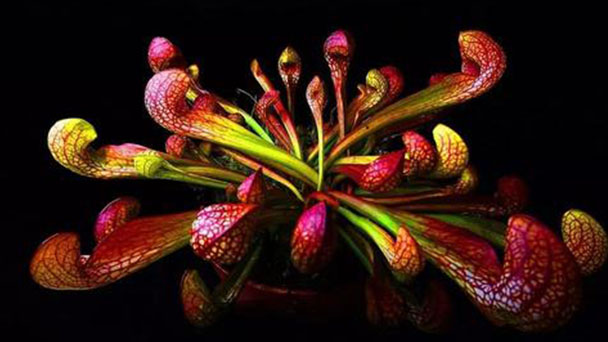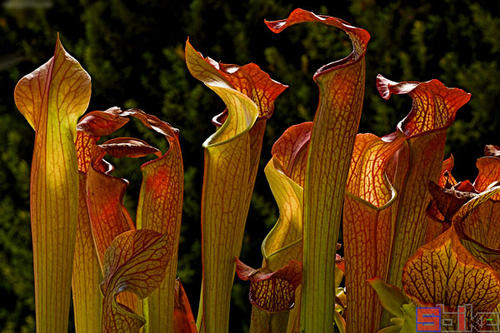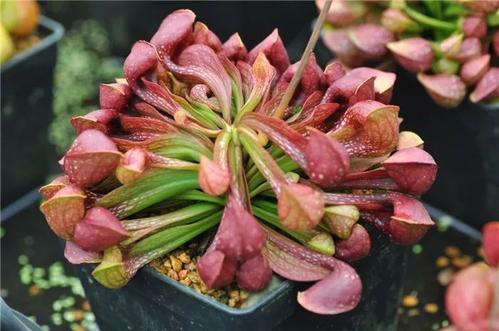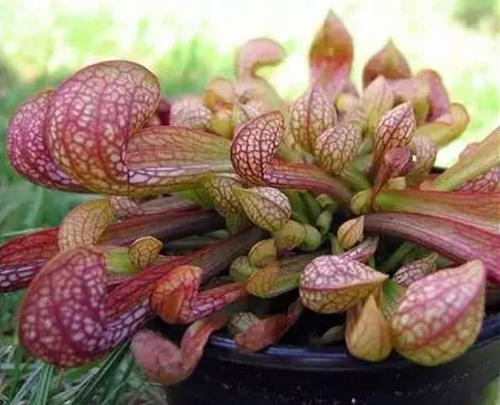Parrot pitcher plant (Sarracenia psittacina) profile
Written by Maggie
Mar 18 2021

The Parrot pitcher plant (Sarracenia psittacina) is a relatively large and elegant insect-eating plant. Parrot pitcher plant has leaves standing upright or lying on its side in a bottle with bright colors and brilliant spots or reticular lines. It looks like a pitcher cage and secrets honey and digestive juice.
The Parrot pitcher plant picture

Parrot pitcher plant morphological characteristics
The leaves of the Parrot pitcher plant lie upright or on their sides in a bottle. They are brightly colored and have brilliant spots or reticulation. They look like a pitcher's cage.
Parrot pitcher plant ecological habits
The leaves of the Parrot pitcher plant lie upright or on their sides in a bottle. They are brightly colored and have brilliant spots or reticulation. They look like a pitcher's cage.
Parrot pitcher plant distribution
The parrot pitcher plant is native to the East Coast of the United States, Texas, the Great Lakes, and southern Canada.
How to grow and care for parrot pitcher plant
Light and temperature
Parrot pitcher plant enjoys being in a shiny mild spot. It want a temperature of 20 to 30 ° C in the summertime , 5 to 15 ° C in the winter. parrot pitcher plant wants seasonality to stay lengthy term. Get him a dormant duration in wintry weather of about three months. A residence is too warm for this plant in winter. If you have bloodless winters, go away and plant outside. Only shield it from dry winds and durations of extreme cold.
Substrate, developing media and repotting
Take a 15 cm pot for a grownup plant. You can use a soil composed of 70% blonde peat , 10% sand , 10% perlite and 10% vermiculite as substrate. During the potting, make a small dome which approves to usually have the collar of the plant barring too much moisture, and to clear well. Do not begin watering too early, however as quickly as the Parrot pitcher plant has a tendency to restart, do not hesitate to supply it water again. Parrot pitcher plant is a little capricious for the wintry weather period. Repot in the course of late iciness and early spring for a sturdy flora in summer.
Watering
In spring and autumn, keep the base of the pot completely in a backside of water. In wintry weather , every now and then immerse your pot in a little rainwater.
Fertilizer
Do no longer fertilize the plants. Kept outside, Parrot pitcher plant will trap extra than ample meals for themselves. If you preserve your plant life indoors, you can feed them with dried bugs each and every few weeks.

Parrot pitcher plant propagation
Parrot pitcher plant can be propagated by seed: Sow the seeds from harvest to fall, which is extra prolific. Or hold the seeds in the backside of the fridge till February. In moisture-saturated mini-greenhouses the sparkling seeds take about three weeks, relying on the temperature for true germination. Seeds that have spent a few months in the fridge are once in a while longer to germinate. It is feasible to repot the younger seedlings at the stop of the year, however it is higher to wait till the following spring.
Sarracenia psittacina can additionally be propagated by means of division: It is clearly the most used technique at Parrot pitcher plant , the division can be carried out at any time of the year. Division via rhizome division in September, with no obvious problem, however need to redouble interest to the extra moisture.
Parrot pitcher plant disease and pest control
A dormant winter period is needed, making this plant not suitable as a houseplant or to tropical climates.

Latest Updated
- Benefits of Bugleweed - 7 Science-backed Health Benefits
- Bugleweed Dangers & Side Effects - Is It Poisonous?
- How to Plant Evergreen Trees - What You Should Know
- When to Plant Evergreens - Grow Guide for Evergreen Trees
- 12 Wonderful Evergreen Shrubs for Your Garden
- 12 Popular Evergreen Plants with Pictures for Beginners
- When And How To Prune A Lilac Bush Like a Pro
- How to Grow & Care for Lilac Vine (Hardenbergia Violacea)
- Japanese Lilac Tree (Syringa Reticulata) Care & Propagation Guide
- Shumard Oak Pros and Cons - What to Know
Popular Articles
- Winter maintenance of Antirrhinum Majus
- How to Grow Terminalia Mantaly Tree
- How to Grow and Care for Crossostephium Chinense
- How to grow Antirrhinum Majus in spring
- Peristeria Elata (Dove Orchid) Profile: Info & Care Guide
- Underwatered Snake Plant (Sansevieria Trifasciata) - Signs And How To Fix
- How to Care for Brazilian Jasmine Plant (Mandevilla Sanderi)
- How to Grow & Care for Graptopetalum Purple Delight in Summer
- Rosa Chinensis (China Rose): Plant Growing & Care Tips
- How to Care for Baby Sun Rose (Aptenia Cordifolia)